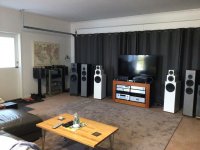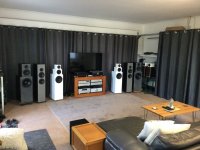Normal gyprock walls with gyprock and curtains behind the speakersThat doesn't tell us much, but rooms are a significant factor in general... By the way, this usually means in regards to room modes, which you should look at for taking control. However there is the possibility your new room is more highly damped. Are the walls flexible?
ill post a pic of the room but something is defiantly amis
Sure. Do you remember what it was like before.. is it broadband absorption or do you have peaks and dips, or both? Do they change much as you move around?
I have attached a couple of photo angles of the room
It is 6 x 6 meters with normal gyprock walls.
Famillier recordings which delved into the lower registers is simply not there as it used to be.
Yes it does change a bit as you walk around the room but it always did before.
Even the Tarkus speaker which I have just recently finished to spec with that 10 inch woofer sounds anemic ( no real bass punch )
Very Frustating
It is 6 x 6 meters with normal gyprock walls.
Famillier recordings which delved into the lower registers is simply not there as it used to be.
Yes it does change a bit as you walk around the room but it always did before.
Even the Tarkus speaker which I have just recently finished to spec with that 10 inch woofer sounds anemic ( no real bass punch )
Very Frustating
Attachments
That's a maybe indicator on modes.it does change a bit as you walk around the room but it always did before.
The next test would be to turn up your bass and see if it's quiet in general. Better still, you could add a sub (or two) so you can manage both issues at the same time.
Adding a sub, it should be seamless and not detectable. If it's your first time setting one up it may sound like it won't blend at first, but in time you'll find the right location, level, polarity, crossover point etc. and the right EQ.
Thanks for your advice AllenB,That's a maybe indicator on modes.
The next test would be to turn up your bass and see if it's quiet in general. Better still, you could add a sub (or two) so you can manage both issues at the same time.
Adding a sub, it should be seamless and not detectable. If it's your first time setting one up it may sound like it won't blend at first, but in time you'll find the right location, level, polarity, crossover point etc. and the right EQ.
yes I suppose a sub is an option,I am adept at intergrating them seemlessly from the surround sound days.
In saying that the Tarkus speakers I have recently built has a 10 inch driver and they still seem lacking in the lower registers?.
As a side note I am now biamping the speakers and have a MF Intergrated and also a MF Power amp.
My question is how do you know that the output from both the Intergrated and the Power Amp is equal and the same?
Do you mean that you have separated the bass and mid/tweeter sections of the Tarkus and are running them through different amps?
If you can't find a gain specification for the amps, you can measure it. If you are limited in equipment you can play a tone through them and measure the output with a multimeter. If you use a meter this way, don't choose a higher frequency for the test (some meters are better closer to mains frequencies).
If you can't find a gain specification for the amps, you can measure it. If you are limited in equipment you can play a tone through them and measure the output with a multimeter. If you use a meter this way, don't choose a higher frequency for the test (some meters are better closer to mains frequencies).
Yes running then through different amps.Do you mean that you have separated the bass and mid/tweeter sections of the Tarkus and are running them through different amps?
If you can't find a gain specification for the amps, you can measure it. If you are limited in equipment you can play a tone through them and measure the output with a multimeter. If you use a meter this way, don't choose a higher frequency for the test (some meters are better closer to mains frequencies).
No way of testing if there outputs are the same .
Just relying on being the same brand and vintage and assuming there given output from the gain is the same.
Am I right in saying the amp with the highest damping factor would be best for bass duties.?
Why, is the damping factor of one of them especially low? If it is you might check the operation of the crossover, which you'd be more sensitive to at the higher frequencies, not lower.
However for the most part it's simply about setting the relative levels, which you can easily do using the existing volume controls.
Not necessarily... if you want to increase your system Q for more bass you can use the lower damping factor.Am I right in saying the amp with the highest damping factor would be best for bass duties.?
However for the most part it's simply about setting the relative levels, which you can easily do using the existing volume controls.
Ok, thanks AllenB, i wasn’t sure and thanks for clearing that up.Why, is the damping factor of one of them especially low? If it is you might check the operation of the crossover, which you'd be more sensitive to at the higher frequencies, not lower.
Not necessarily... if you want to increase your system Q for more bass you can use the lower damping factor.
However for the most part it's simply about setting the relative levels, which you can easily do using the existing volume controls.
Always appreciate your input
- Home
- Loudspeakers
- Multi-Way
- Help with a replacement SB23NRXS45-8 8 Inch driver

